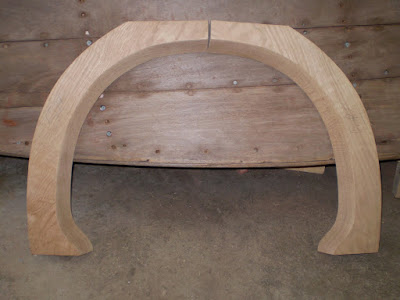With 20 hrs. of work it took to make the two transom cheeks, cracks have appeared on both of them. Can't believe it.... I made them almost a year ago with good, flat sawn White Oak. And no sign of checking during this time. As soon as I assembled the transom frame, the checking started. And the cracks are almost 1/3 of the thickness.
My guess is that the tension from being mounted in the the frame made them fail now.
Now, let's talk about the poor design for a moment. This was bound to happen. The barrelbacks cheeks are quarter-round, and made out of one piece of wood. Originally they used Mahogany in this boat, but chose to use White Oak as described in Dannenberg's book. Still, there is no strength in this single piece of wood, shaped like this, regardless on species.
And as Danneberg write in his book, the cheeks are almost always broken on every boat his been working on.
Now, what is the solution? Anything other than original will upset the purists, which all boat show judges are. I'm also committed to stay true to the original design. But then again, this design is wrong, and I feel that the original designed cheeks will brake sooner than later regardless.
Lamination? I've been struggling with finding the right answer. Laminate two pieces together? Three, with the center piece being two pieces jointed together at a 30-40 dgr. angle to get more straight grain holding power?
Well, after discussing with several "Woodies", I've decided to laminate two pieces together. This will increase the strength and checking resistance VS. a single piece of wood and still remain very close to the original design. The glue line will be close to invisible after painting.
From what I have read and know about wood movement, epoxy lamination is out of the questions with solid wood. So I'm choosing to laminate with 3M5200. From the information I gather from professional restorers, 3M5200 will not de-laminate and is of course THE recommended adhesive for wooden boat work.
Am I right, am I wrong? Please comment!











